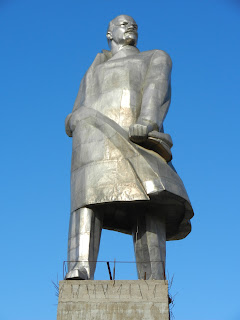‘Tender the gold of the white atlas boon,
Green is the sheen of its robe iridescent
Under the hot gleaming sun of high noon.
Aidin Sabirova, Uzbek Poetess
(reprinted in Dawn over
Samarkand, p.160)
One of the earlier posts has already introduced Joshua
Kunitz’s book. It is worth revisiting for its picturesque and telling story of
post-revolutionary Central Asian cotton. It is described in the Dawn over
Samarkand ninth chapter “Where cotton is king”:
.jpg) |
| Cotton harvester, vicinities of Osh, 2010 |
‘Whether one reads local papers, or listens to orators, or
converses with workers, or visits schools, movies, unions, cooperatives, the
first word or derivation from that word one is likely to see or hear is khlopok
– cotton – the “white gold” of Central Asia. People here talk cotton, sing
cotton, play cotton, work cotton, study cotton, dream cotton. Even the struggle
with the counter-revolutionary Basmachi, until recently of intense concern to
the people of central Asia, has now receded to a place of secondary importance.
(…) Though tremendously stimulated by the Soviet Government, the Central Asia’s
interest in cotton is not new. Cotton of inferior sorts has been grown here for
centuries. One of the chief incentives of the czars for extending their
imperial power to remote Central Asia was their determination to obtain cotton
for Russia. Most of the Russian colonizers of Central Asia were people who in
some direct or indirect sense were connected with cotton. Central Asian cotton
was the basis of the rapid growth of the textile industries in the Northern
capitals, and the source of immense private fortunes in Russia. After 1914,
Russia’s hunger for cotton increased a hundredfold.’
Nothing more than the cotton triggered the construction of the
Turksib railway. The line was to facilitate the transportation of cotton from
Turkestan to Siberia and grain from Russia to Central Asia. The construction of
the Turkestan-Siberian railway was portrayed in an outstanding documentary of
1929 ‘Turksib’. This masterpiece of cinematography and an example of skilful
propaganda depicts the arrival of modernity in Soviet Turkestan and it will
definitely feature in more detail in one of the future posts.
But back to cotton and Dawn over Samarkand. Kunitz, after
explaining why the demand for cotton has grown in the post-WWI years, calls:
“For Cotton – For Socialism!” and embarks on attacking what he calls
“anti-cotton propaganda” which had supposedly been developing in the Soviet
Union. What constituted this “propaganda” were mainly scholarly discussions,
which Kunitz ridicules for their excessive scepticism and the absence of
anti-capitalist rhetoric. These cotton concerns stemmed from the example of the
South of the United States where cotton cultivation, among other things,
exhausted the soil and aggravated racism.
‘It has always been a source of wonderment to me how the
Soviet Government, in face of the concerted opposition and constant sabotage of
the leading cotton experts, has managed to advance so rapidly toward cotton
independence’’ (Dawn over Samarkand, p. 165).
.jpg) |
| Cotton harvester, vicinities of Osh, 2010 |
Kunitz, himself being utterly persuaded, explains how cotton
is the best way towards regional specialization in the Soviet Union, which in
turn makes national interdependence possible. Undoubtedly, large-scale cotton
cultivation brings about also industrialization, which, undeniably, contributes
to the fulfilment of the revolutionary ideal: ‘An increase in the number of
native proletarians brings the communist dream closer to realization. (…) Then
again, territorial specialization makes not only for national interdependence,
but also for class interdependence (…) In view of all this, it is no
exaggeration to say that cotton is the magic key to the maze of economic, political,
and cultural inroads the Bolsheviks have made into the age-long immutability of
Central Asian existence. (…) cotton is the natural medium through which the
Bolshevik ideal can be realized’ (Dawn
over Samarkand, p. 167).













.JPG)










